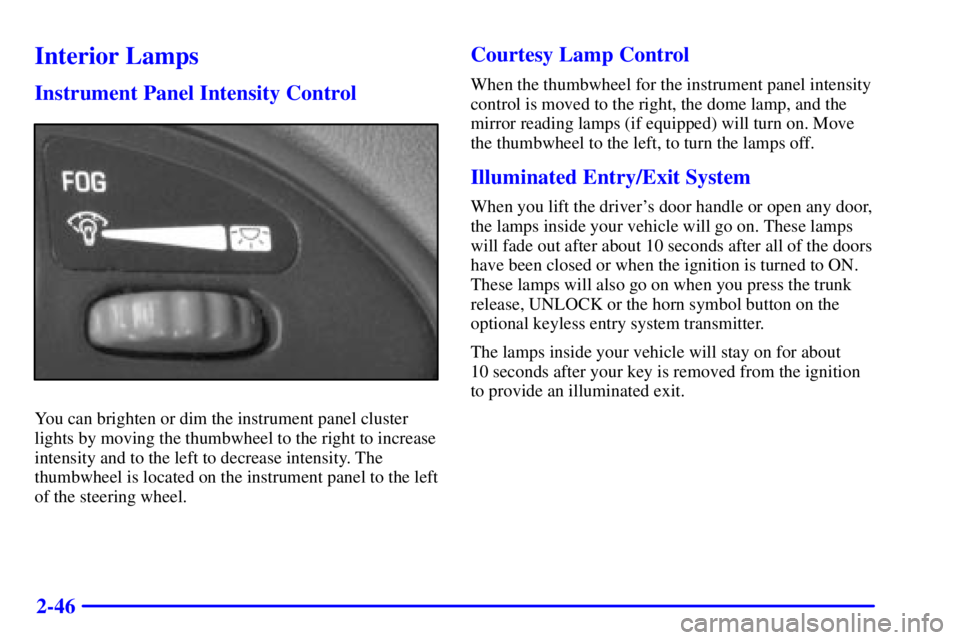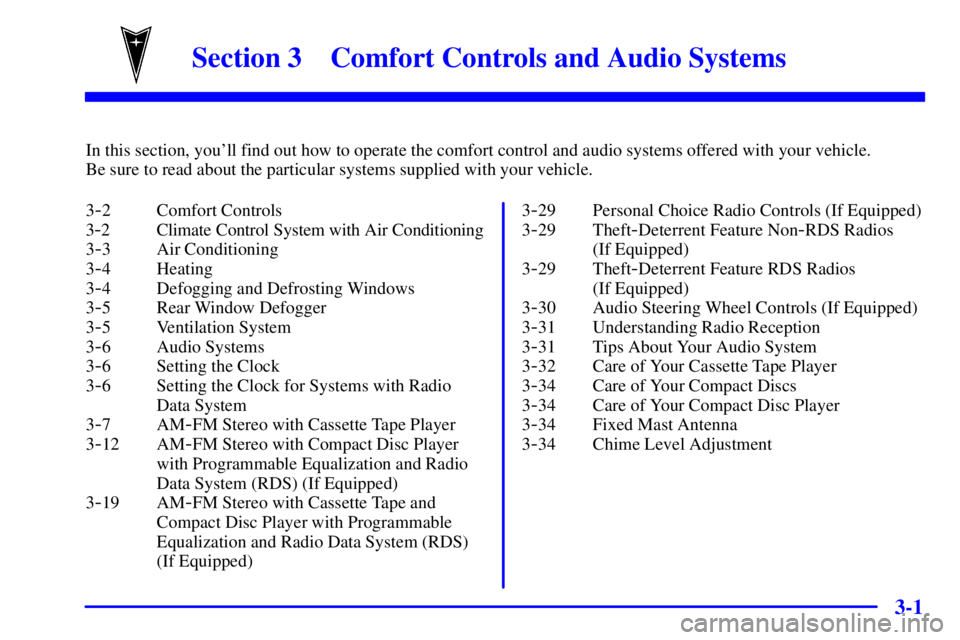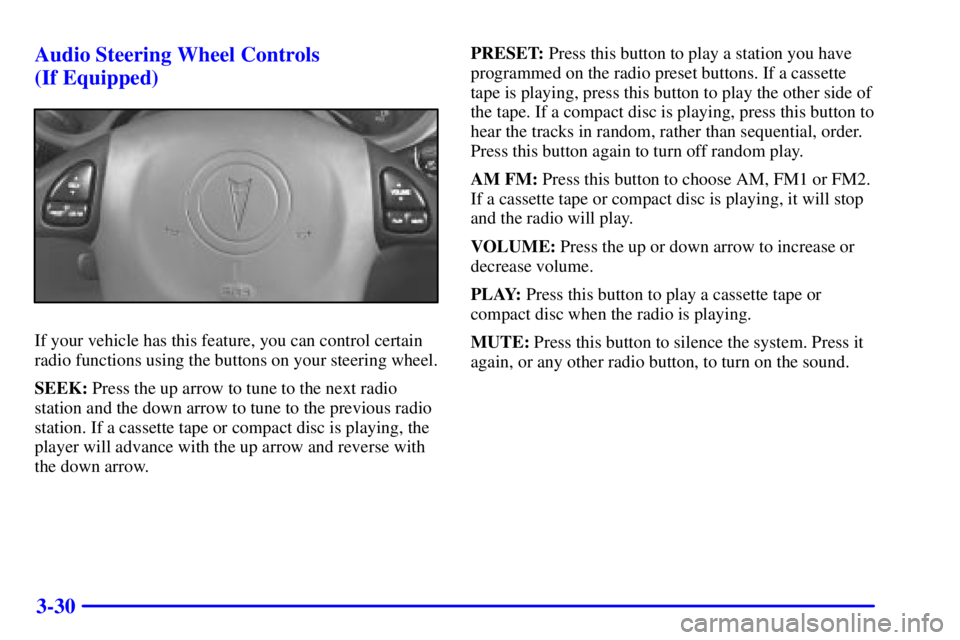Page 115 of 341
2-45 Delayed Headlamps
The delayed headlamps feature will continue to
illuminate the headlamps for 20 seconds after the key is
turned to OFF, then the headlamps will automatically
turn off.
To override the 20 second delayed headlamp feature
while it is active turn the turn signal/multifunction lever
up one position and then back to AUTO.
Fog Lamps
The button for your fog
lamps is located on the
instrument panel, to the left
of the steering wheel, beside
the instrument panel
intensity control.When using the fog lamps, the ignition must be on as
well as the parking lamps or the low
-beam headlamps.
Push the button to turn the fog lamps on. An indicator
light on the button will glow when the fog lamps are on.
Push the button again to turn the fog lamps off.
The fog lamps will turn off whenever the high
-beam
headlamps are turned on. When the high beams are
turned off, the fog lamps will come on again.
Page 116 of 341

2-46
Interior Lamps
Instrument Panel Intensity Control
You can brighten or dim the instrument panel cluster
lights by moving the thumbwheel to the right to increase
intensity and to the left to decrease intensity. The
thumbwheel is located on the instrument panel to the left
of the steering wheel.
Courtesy Lamp Control
When the thumbwheel for the instrument panel intensity
control is moved to the right, the dome lamp, and the
mirror reading lamps (if equipped) will turn on. Move
the thumbwheel to the left, to turn the lamps off.
Illuminated Entry/Exit System
When you lift the driver's door handle or open any door,
the lamps inside your vehicle will go on. These lamps
will fade out after about 10 seconds after all of the doors
have been closed or when the ignition is turned to ON.
These lamps will also go on when you press the trunk
release, UNLOCK or the horn symbol button on the
optional keyless entry system transmitter.
The lamps inside your vehicle will stay on for about
10 seconds after your key is removed from the ignition
to provide an illuminated exit.
Page 123 of 341
2-53
The main components of your instrument panel are the following:
A. Fog Lamp Switch
B. Instrument Panel Intensity Control
C. Turn Signal/Multifunction Lever
D. Horn
E. Instrument Panel Cluster
F. Windshield Wiper/Washer Lever
G. Ignition Switch
H. Enhanced Traction System
I. Hazard Warning Flashers ButtonJ. Instrument Panel Fuse Blocks
K. Hood Release Handle
L. Tilt Wheel Lever
M. Audio System Steering Wheel Controls
(If Equipped)
N. Cruise Control Switches (If Equipped)
O. Shift Lever
P. Cigarette Lighter
Q. Climate Control System
R. Audio System
Page 140 of 341

3-
3-1
Section 3 Comfort Controls and Audio Systems
In this section, you'll find out how to operate the comfort control and audio systems offered with your vehicle.
Be sure to read about the particular systems supplied with your vehicle.
3
-2 Comfort Controls
3
-2 Climate Control System with Air Conditioning
3
-3 Air Conditioning
3
-4 Heating
3
-4 Defogging and Defrosting Windows
3
-5 Rear Window Defogger
3
-5 Ventilation System
3
-6 Audio Systems
3
-6 Setting the Clock
3
-6 Setting the Clock for Systems with Radio
Data System
3
-7AM-FM Stereo with Cassette Tape Player
3
-12 AM-FM Stereo with Compact Disc Player
with Programmable Equalization and Radio
Data System (RDS) (If Equipped)
3
-19 AM-FM Stereo with Cassette Tape and
Compact Disc Player with Programmable
Equalization and Radio Data System (RDS)
(If Equipped)3
-29 Personal Choice Radio Controls (If Equipped)
3
-29 Theft-Deterrent Feature Non-RDS Radios
(If Equipped)
3
-29 Theft-Deterrent Feature RDS Radios
(If Equipped)
3
-30 Audio Steering Wheel Controls (If Equipped)
3
-31 Understanding Radio Reception
3
-31 Tips About Your Audio System
3
-32 Care of Your Cassette Tape Player
3
-34 Care of Your Compact Discs
3
-34 Care of Your Compact Disc Player
3
-34 Fixed Mast Antenna
3
-34 Chime Level Adjustment
Page 169 of 341

3-30 Audio Steering Wheel Controls
(If Equipped)
If your vehicle has this feature, you can control certain
radio functions using the buttons on your steering wheel.
SEEK: Press the up arrow to tune to the next radio
station and the down arrow to tune to the previous radio
station. If a cassette tape or compact disc is playing, the
player will advance with the up arrow and reverse with
the down arrow.PRESET: Press this button to play a station you have
programmed on the radio preset buttons. If a cassette
tape is playing, press this button to play the other side of
the tape. If a compact disc is playing, press this button to
hear the tracks in random, rather than sequential, order.
Press this button again to turn off random play.
AM FM: Press this button to choose AM, FM1 or FM2.
If a cassette tape or compact disc is playing, it will stop
and the radio will play.
VOLUME: Press the up or down arrow to increase or
decrease volume.
PLAY: Press this button to play a cassette tape or
compact disc when the radio is playing.
MUTE: Press this button to silence the system. Press it
again, or any other radio button, to turn on the sound.
Page 174 of 341
4-
4-1
Section 4 Your Driving and the Road
Here you'll find information about driving on different kinds of roads and in varying weather conditions. We've also
included many other useful tips on driving.
4
-2 Defensive Driving
4
-3 Drunken Driving
4
-6 Control of a Vehicle
4
-6 Braking
4
-9 Enhanced Traction System
4
-11 Steering
4
-13 Off-Road Recovery
4
-13 Passing
4
-15 Loss of Control
4
-16 Driving at Night
4
-17 Driving in Rain and on Wet Roads4
-20 City Driving
4
-21 Freeway Driving
4
-22 Before Leaving on a Long Trip
4
-23 Highway Hypnosis
4
-24 Hill and Mountain Roads
4
-25 Winter Driving
4
-29 Recreational Vehicle Towing
4
-32 Loading Your Vehicle
4
-34 Towing a Trailer
4
-40 Towing a Trailer (2.4L L4 Engine)
Page 179 of 341

4-6
Control of a Vehicle
You have three systems that make your vehicle go where
you want it to go. They are the brakes, the steering and
the accelerator. All three systems have to do their work
at the places where the tires meet the road.
Sometimes, as when you're driving on snow or ice, it's
easy to ask more of those control systems than the tires
and road can provide. That means you can lose control
of your vehicle. Also see ªEnhanced Traction Systemº
in the Index.
Braking
Braking action involves perception time and
reaction time.
First, you have to decide to push on the brake pedal.
That's perception time. Then you have to bring up your
foot and do it. That's reaction time.
Average reaction time is about 3/4 of a second. But
that's only an average. It might be less with one driver
and as long as two or three seconds or more with
another. Age, physical condition, alertness, coordination
and eyesight all play a part. So do alcohol, drugs and
frustration. But even in 3/4 of a second, a vehicle
moving at 60 mph (100 km/h) travels 66 feet (20 m).
That could be a lot of distance in an emergency, so
keeping enough space between your vehicle and others
is important.
And, of course, actual stopping distances vary greatly
with the surface of the road (whether it's pavement or
gravel); the condition of the road (wet, dry, icy); tire
tread; the condition of your brakes; the weight of the
vehicle and the amount of brake force applied.
Page 182 of 341

4-9
Remember: Anti-lock doesn't change the time you need
to get your foot up to the brake pedal or always decrease
stopping distance. If you get too close to the vehicle in
front of you, you won't have time to apply your brakes
if that vehicle suddenly slows or stops. Always leave
enough room up ahead to stop, even though you have
anti
-lock brakes.
Using Anti
-Lock
Don't pump the brakes. Just hold the brake pedal down
firmly and let anti
-lock work for you. You may feel a
slight brake pedal pulsation or notice some noise, but
this is normal.
Braking in Emergencies
With anti-lock, you can steer and brake at the same
time. In many emergencies, steering can help you more
than even the very best braking.
Enhanced Traction System
Your vehicle is equipped with an Enhanced Traction
System (ETS) that limits wheel spin. This is especially
useful in slippery road conditions. The system operates
only if it senses that one or both of the front wheels are
spinning or beginning to lose traction. When this
happens, the system reduces engine power and may also
upshift the transaxle to limit wheel spin.
This light will come on
when your Enhanced
Traction System is limiting
wheel spin. See ªEnhanced
Traction System Active
Lightº in the Index.
You may feel or hear the system working, but this is
normal. This light will also come on when the anti
-lock
brake system is working.
If your vehicle is in cruise control when the enhanced
traction system begins to limit wheel spin, the cruise
control will automatically disengage. When road
conditions allow you to safely use it again, you may
reengage the cruise control. See ªCruise Controlº in
the Index.